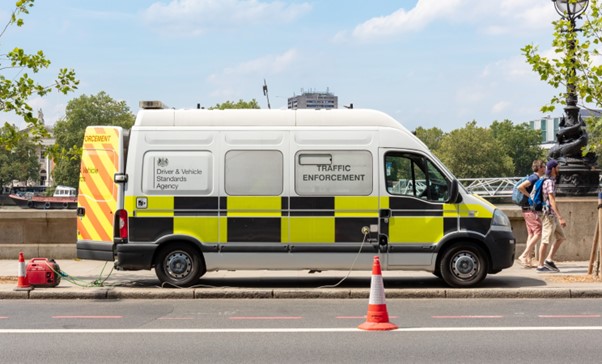
Susie Jones
Vysvetlenie kontrol DVSA pre nákladné vozidlá
Vytvorené: 08. 08. 2024
•
Aktualizované: 08. 08. 2024
Počas vašej kariéry vodiča nákladného vozidla vás môže zastaviť Agentúra pre štandardy vodičov a vozidiel (DVSA). Pre nových vodičov nákladných vozidiel to môže byť skľučujúci proces. Pochopenie základných aspektov kontrol DVSA pre nákladné vozidlá však môže tento proces urobiť menej stresujúcim.
Kto je DVSA?
Podľa Gov.uk je DVSA zodpovedná za "vykonávanie cestných kontrol komerčných vodičov a vozidiel, aby sa uistila, že dodržiavajú bezpečnostné pravidlá a udržiavajú svoje vozidlo bezpečné na jazdu".
DVSA môže vykonať námatkovú kontrolu vášho nákladného vozidla a vydať zákaz. Zákazy bránia vodičovi nákladného vozidla v jazde, kým sa problém s jeho vozidlom nevyrieši.
Polícia má tiež právomoc zastaviť vodiča nákladného vozidla a vykonať podobné kontroly.
Ako vyzerajú skúšajúci DVSA?
Existuje niekoľko spôsobov, ako identifikovať skúšajúceho DVSA. Budú nosiť žlté viditeľné vesty s logom DVSA a vždy budú mať preukaz skúšobného komisára. Ich vozidlá majú čierno-žltú potlač s logom DVSA na kapote.

Čo sa stane, ak vás zastavia?
Nezastavenie na výzvu kontrolóra DVSA je priestupok. Ak vás skúšajúci vyzve, aby ste zastavili, vykoná kontrolu na okraji cesty alebo na vyhradenom testovacom mieste. Hlavným účelom týchto zastavení je zabrániť tomu, aby sa na cestách objavili nebezpečné vozidlá.
Skúšajúci vykoná tieto povinné kontroly:
Kontrola povolenej hmotnosti nákladu a typu nákladu
Kontrola mechanických porúch a technickej spôsobilosti
Zabezpečenie správnosti záznamov tachografu
Uistite sa, že máte platný vodičský preukaz.
Ako dlho trvá obchádzková kontrola DVSA?
Obhliadka DVSA trvá v priemere 15 minút. V prípadoch, keď nákladné vozidlo nespĺňa bezpečnostné požiadavky, však môže trvať dlhšie. Skúšajúci musí vykonať potrebné kontroly bez ohľadu na čas.
Ako sa uistiť, že je vaše vozidlo spôsobilé na premávku
Vodič je zodpovedný za to, aby jeho vozidlo bolo spôsobilé na premávku na pozemných komunikáciách. Pred každou jazdou sa odporúča vykonať obchádzkovú kontrolu.
Skontrolujte nasledujúce položky:
Svetlá
Ukazovatele
Palivo a olej
Pneumatiky
Upevňovacie prvky kolies
Práca s telom
Spojenie prívesu
Náklad a iné vybavenie
Kontrola vozidla v kabíne (napr. bezpečnostné pásy, klaksón, stierače, ostrekovače, riadenie a ukazovateľ výšky).
Okrem toho je vodič nákladného vozidla povinný písomne nahlásiť všetky závady svojej organizácii. Tieto by mali obsahovať nasledujúce informácie:
Registračná alebo identifikačná značka vozidla
Dátum kontroly
Podrobnosti o závadách
Meno osoby, ktorá nahlasuje nedostatky.
Povinnosti operátora
Prevádzkovatelia vozidiel sú zodpovední za bezpečnosť svojich vozidiel a musia vykonávať tieto činnosti:
Prevádzkovateľ musí zabezpečiť pravidelné bezpečnostné kontroly všetkých úžitkových vozidiel
Musia zabezpečiť, aby ich vodiči pochopili, aké kontroly je potrebné vykonať.
Zákazy pri cestách
Ak vaše nákladné vozidlo nie je spôsobilé na prevádzku na pozemných komunikáciách, DVSA vám môže vydať dve rôzne oznámenia o zákaze - okamžité alebo odložené.
Okamžité oznámenie o zákaze:
Môže nadobudnúť účinnosť okamžite
Vo väčšine prípadov vedie k znehybneniu vozidla
Okamžité zákazy môžu viesť k trestnému stíhaniu.
Oneskorené oznámenie o zákaze:
Prevádzkovateľ má na vyriešenie problémov až 10 dní.
Po desiatich dňoch policajti vozidlo znovu skontrolujú.
Pred jazdou nákladného vozidla sa musia odstrániť zákazy.
Zákazy týkajúce sa technickej spôsobilosti
Ak má nákladné vozidlo mechanické problémy alebo ak sú karoséria a vybavenie na nízkej úrovni, vydá sa zákaz technickej kontroly. V prípade vozidiel mimo Spojeného kráľovstva dostane vodič okamžitý zákaz. V prípade prevádzkovateľov v Spojenom kráľovstve bude typ zákazu závisieť od toho, o akú závažnú závadu ide.
Drobné chyby:
Drobné nedostatky môžu mať za následok oneskorený zákaz
Prevádzkovateľ bude mať na odstránenie prípadných nedostatkov až desať dní.
Opätovná kontrola sa uskutoční po desiatich dňoch.
Závažné chyby:
Vodič dostane zákaz činnosti označený písmenom "S" za závažnú chybu
Zákaz označený písmenom "S" nastáva v prípade problému s údržbou
Ak skúšajúci rozhodne, že neexistuje bezprostredné riziko, zákazy sa môžu odložiť.
Vozidlo bude odstavené a môžete byť trestne stíhaní.
Zákaz označený písmenom "S" sa nevyskytuje v prípade nasledujúcich prípadov:
Ak sa počas cesty vyskytne problém
Problém nebolo možné zistiť (napr. defekt spodnej strany).

Zákazy preťažovania
Ak je vozidlo preťažené, inšpektor DVSA ho môže znehybniť. Prípadne môže skúšajúci nasmerovať vozidlo na blízke miesto, kde sa náklad môže prerozdeliť alebo odstrániť. Prevádzkovateľ vozidla dostane oznámenie.
Zákazy hodín pre vodičov
Vodiči, ktorí nedodržali pravidlá pre tachograf a hodiny vodiča, dostanú zákaz. V prípade porušenia tohto zákazu môže byť uložená pokuta, trestné stíhanie alebo môže byť vozidlo odstavené.
Viac informácií o pravidlách a predpisoch pre tachografy
Hoci skúšky DVSA môžu byť pre vodičov nákladných vozidiel odstrašujúcim príkladom, sú nesporne pozitívnym prínosom pre bezpečnosť cestnej premávky. Zabezpečenie správnych kontrol a dodržiavanie základných pravidiel a predpisov bude mať za následok bezproblémový priebeh skúšky DVSA.
Ako dlho musíte uchovávať hárky s chybami nákladných vozidiel?
Zavedenie systému hlásenia nulových závad môže byť vašou prvou obrannou líniou pri preukazovaní, že vaše vozidlá sú v stave spôsobilom na premávku. Práce na odstraňovaní závad by sa mali nahlasovať a uchovávať až 15 mesiacov. V prípade, že sa nevyskytli žiadne závady, spoločnosť by mala viesť záznamy, aby sa uistila, že vodiči vykonávajú kontroly.
Ako často potrebujete lekársku prehliadku, aby ste si udržali vodičský preukaz?
Na získanie a držanie preukazu na nákladné vozidlá je potrebné absolvovať zdravotnú prehliadku - bez nej vám nebude vydaný preukaz.
Pre vodičov mladších ako 45 rokov platí zdravotné poistenie do 45. narodenín. Po dosiahnutí tohto veku však budete musieť absolvovať lekársku prehliadku každých päť rokov až do veku 65 rokov. Vodiči vo veku 65 rokov a viac musia absolvovať lekársku prehliadku každý rok.



